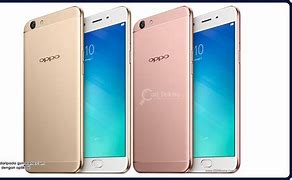Harga dan Spesifikasi Oppo F1S
Oppo F1S adalah salah satu seri ponsel Oppo yang banyak diincar oleh penggemar brand ini. Sebab, hp tersebut menonjolkan keunggulan kamera depan 16 MP.
Pada saat itu hp Android dengan kamera depan 16 MP dapat menghasilkan foto selfie yang memiliki detail terbaik. Apalagi Oppo F1S sudah dilengkapi sejumlah fitur yang membuat hasil foto selfie semakin menarik.
Untuk saat ini produk ponsel Oppo F1S memang masih beredar di pasaran. Sayangnya, hp tersebut dijual sebagai barang bekas pakai. Mengingat ponsel tersebut dijual dalam kondisi second, satu unit hp Oppo F1S tersebut pasti harganya sudah mengalami penurunan.
Kalau melihat dari beberapa platform e-commerce, harga hp Oppo FS1 tahun 2022 berada di kisaran Rp 1 jutaan. Perlu diingat angka tersebut bukan harga pasti. Sebab, banyak pertimbangan untuk menentukan seberapa besar harga Oppo F1S bekas. Maka dari itu, sebaiknya Anda pelajari dan cermati informasi mengenai Oppo F1S spesifikasi dan kondisinya. Sehingga Anda bisa menebak harga sesuai dengan budget yang dimiliki.
Walaupun ponsel ini dirilis pada 2016, desain Oppo F1S sebenarnya tidak terlalu ketinggalan zaman. Secara tampilan, ponsel yang mengedepankan keunggulan kamera selfie tersebut terlihat berkelas.
Kesan premium ini nampak pada penggunaan material alumunium di bagian frame serta back cover. Bukan hanya itu saja, ponsel ini memiliki lebar dan tipis yang sangat nyaman untuk digenggam. Adapun detail ukuran Oppo F1S adalah memiliki ketebalan 7,38 mm, tinggi 145,5 mm, dan lebar 76 mm. Ponsel ini juga punya bobot sangat ringan, karena beratnya hanya 160 gram.
Seperti yang disebutkan sebelumnya, ponsel ini sangat mengunggulkan kamera depannya yang sering disebut selfie expert. Oppo F1S spesifikasi detailnya dibekali kamera depan 16 MP yang didukung sensor 1/3,1 inci dan aperture f/2,0.
Jika dikombinasikan dengan sejumlah fitur pada ponsel tersebut, maka hasil foto selfie Anda akan terlihat menarik dan jadi lebih bagus. Untuk kamera belakang, Oppo F1S menggunakan single camera 13 MP dengan sensor 1/3,6 inci. Hp ini diklaim memiliki sensitivitas cahaya yang tinggi, serta dapat bekerja cukup baik di malam hari.
Menurut Iprice.co.id, hp Oppo F1S spesifikasi layarnya menggunakan panel LCD IPS dengan resolusi layar 1.280 x 720 piksel dan kerapatan piksel 276 ppi. Ukuran layarnya cukup lebar bagi smartphone entry level, yakni layar 5,5 inci.
Dari segi kapasitas daya, ponsel tersebut ditenagai dengan baterai 3.075 mAH. Sedangkan pengisian dayanya akan memakan waktu yang standar.
Dari segi performa, sebaiknya Anda jangan memasang ekspektasi terlalu tinggi. Sebab, ponsel ini hanya menggunakan prosesor octa-core versi lawas yang belum ditingkatkan. Kemudian, hp ini menggunakan chipset MediaTek 6750 dengan versi Android 5.
Meski demikian, Oppo F1S dinilai punya kinerja dan performa yang stabil untuk ponsel entry level. Hp ini menggunakan RAM 3/4GB dan kapasitas memori internalnya adalah 32/64GB.
Berdasarkan penjelasan di atas, singkatnya performa hp Oppo F1S sangat baik, walaupun sektor tersebut bukanlah sesuatu yang paling diunggulkan pada ponsel tersebut.
Demikian gambaran singkat mengenai informasi hp Oppo F1S spesifikasi dan harganya. Ponsel ini dirancang khusus agar penggunanya dapat menangkap dan mengabadikan momen, lewat kamera selfie terbaik di masanya.
TRIBUNMANADO.CO.ID - Berikut ini informasi Harga HP dan spesifikasi Oppo F1s.
HP Oppo F1s ini pertama kali dirilis pada Agustus 2016.
Saat itu, harga HP Oppo F1s dibanderol hampir Rp 4 jutaan.
Namun kini, Harga HP Oppo F1s ini dibandrol dibawah Rp 1 juta.
Meski seri lama, namun spesifkasi HP Oppo tersebut masih mumpuni jika digunakan di tahun 2023.
Baca juga: Harga HP dan Spesifikasi Oppo Reno4 F, Gawai Paling Tipis Miliki Sejumlah Spek Gahar
Berikut Harga Hp dan spesifikasi Oppo F1s, Maret 2023.
1. Penyimpanan ROM/RAM: 32GB +3GB, 64GB +4GB
2. Resolusi layar: 720 x 1280 pixels, 16:9 ratio (~267 ppi density)
3. Kamera belakang: 13 MP, f/2.2, 1/3", PDAF
- Kualitas video: 1080p@30fps
-Mode pemotretaan: LED flash, HDR, panorama
4. Kamera depan: 16 MP, f/2.0, 26mm (wide), 1/3.06", 1.0µm
- Kualitas video: 1080p@30fps
5. OS: Android 5.1 (Lollipop), upgradable to 6.0 (Marshmallow), ColorOS 3
- Chipset: Mediatek MT6755 (28 nm) or MTK7650 (28 nm)
- CPU: Octa-core 1.5 GHz Cortex-A53
Baca juga: Harga HP iPhone 14 Pro Max Terbaru di Maret 2023, Turun Drastis Hingga Rp1 Juta
6. Baterai: Li-Po 3075 mAh
7. Harga HP: mulai Rp 650.000 berdasarkan e-commere (Shopee) per Minggu (12/3/2023).
8. Warna: Gold, Rose Gold, Gray
Baca Berita Tribun Manado Terbaru DI SINI
Baca Berita Lainnya di Google News
Offenbar hast du diese Funktion zu schnell genutzt. Du wurdest vorübergehend von der Nutzung dieser Funktion blockiert.
Wenn dies deiner Meinung nach nicht gegen unsere Gemeinschaftsstandards verstößt,
Sejak dahulu Oppo dikenal sebagai produsen smartphone yang fokus mengembangkan ponsel untuk kebutuhan selfie. Salah satunya seperti Oppo F1S spesifikasi dan kameranya yang dirancang khusus pada segmen ini.
Handphone (hp) Oppo F1S memang bukan produk baru. Akan tetapi, kalau kita melihat detail informasi mengenai Oppo F1S spesifikasi, maka ponsel ini masih dapat digunakan saat ini. Apabila dibandingkan dengan ponsel Oppo masa kini, pastinya Oppo F1S spesifikasi dan kualitasnya akan tertinggal jauh.
Ponsel tersebut diluncurkan pertama kali pada Agustus 2016. Pada masanya, Oppo F1S punya kelebihan pada kamera depan yang dinilai memiliki kualitas bagus. Jika Anda tengah mencari informasi seputar hp Oppo F1S spesifikasi dan harganya, simak artikel sampai tuntas.
Dihimpun dari situs resmi Oppo dan sumber lainnya, berikut gambaran ringkas mengenai spesifikasi Oppo F1S.
Điện thoại OPPO F1s (2017) 64GB Vàng Hồng A1601GR
Tiếp nối sự thành công của dòng sản phẩm OPPO F1s, OPPO tiếp tục giới thiệu đến thị trường Việt Nam phiên bản nâng cấp của dòng sản phẩm này với tên gọi OPPO F1s 2017, đặc biệt trong số đó có phiên bản màu vàng hồng nhận được sựt quan âm của đông đảo người dùng. Máy sở hữu thiết kế sang trọng cuốn hút, cấu hình được nâng cấp mạnh mẽ hơn so với phiên bản cũ, kết hợp cùng hệ thống camera sắc nét chắc chắn sẽ đem đến cho bạn những trải nghiệm hoàn toàn mới.
Thiết kế sang trọng cuốn hút với màu vàng hồng thời thượng
Điện thoại OPPO F1s (2017) 64GB Vàng Hồng A1601GR được chế tạo từ hợp kim nhôm, các góc cạnh máy được bo tròn vừa phải, kích thước tổng thể khá vừa vặn với chiều dài máy là 154.5 mm, rộng 76 mm, chỉ dày 7.38mm cùng với trọng lượng nhẹ chỉ 160g giúp bạn có cảm giác thoải mái khi cầm máy. Bên cạnh đó, màu vàng hồng cũng góp phần đem lại cho OPPO F1s 2017 một vẻ ngoài sang trọng, cuốn hút.
Màn hình IPS LCD hiển thị sắc nét
Điện thoại OPPO F1s (2017) 64GB Vàng Hồng A1601GR có kích thước màn hình lớn lên đến 5.5 inch, với độ phân giải đạt 1280 x 720 pixels, kết hợp với công nghệ màn hình IPS LCD và được phủ bởi kính cường lực Gorilla Glass 4 cho hình ảnh hiển thị rõ ràng và sắc nét.
Cấu hình mạnh mẽ hơn, ổn định hơn
OPPO F1s 64GB Vàng Hồng 2017 được trang bị bộ vi xử lý 8 nhân MediaTek MT6750 tốc độ 1.5 GHz, kết hợp với chip đồ họa Mali-T860 MP2 và bộ nhớ RAM dung lượng 4 GB đem đến cho máy một hiệu năng ổn định, đủ để đáp ứng các nhu cầu tác vụ của người dùng smartphone hiện nay.
Đồng thời, bộ nhớ trong của OPPO F1s 2017 cũng được nâng cấp với dung lượng lớn hơn lên đến 64 GB, cùng với khả năng hỗ trợ thẻ nhớ ngoài MicroSD dung lượng hỗ trợ tối đa 128 GB, đem đến cho máy một khả năng lưu trữ tốt.
Selfie cực chất cùng camera của OPPO F1s (2017) 64GB Vàng Hồng.
OPPO F1s 2017 sở hữu camera trước có độ phân giải lên đến 16 MP, cảm biến 1/3.1 inch và khẩu độ lớn f/2.0, kết hợp cùng những tính năng độc đáo, giúp người dùng có những bức ảnh selfie cực chất, chất lượng hình ảnh tốt.
Ngoài ra, OPPO F1s (2017) 64GB Vàng Hồng còn được trang bị camera sau với độ phân giải đạt 13 MP cùng tính năng tự động lấy nét và nhiều tính năng khác cho phép người dùng sở hữu những bức ảnh rõ ràng, sắc nét, nhanh chóng và chính xác.
OPPO F1s (2017) 64GB Vàng Hồng được trang bị pin Lithium-Ion, dung lượng pin 3075 mAh, kết hợp cùng hệ điều hành ColorOS 3.0 cho khả năng tiết kiệm pin hiệu quả. Máy sẽ tự động chuyển các ứng dụng nền về chế độ chờ để tiết kiệm pin và bộ nhớ. Ngoài ra, sản phẩm cũng sẽ tự tắt các ứng dụng tiêu thụ pin trong lúc tắt màn hình để đảm bảo mức năng lượng tốt nhất cho ngày dài hoạt động
Information about the width, i.e. the horizontal side of the device when it is used in its standard orientation.
Information about the height, i.e. the vertical side of the device when it is used in its standard orientation.
Information about the thickness/depth of the device in different measurement units.
Information about the weight of the device in different measurement units.
Estimated volume of the device, calculated from the dimensions provided by the manufacturer. Applies for devices in the form of a rectangular parallelepiped.
Information about the colors, in which the device is available in the market.
Materials used in the fabrication of the device's body.
GSM (Global System for Mobile Communications) was developed to replace the analog cellular network (1G), therefore it is referred to as a 2G mobile network. It has been improved with the addition of General Packet Radio Services (GPRS) and later via the Enhanced Data rates for GSM Evolution (EDGE) technology.
CDMA (Code-Division Multiple Access) is a channel access method for communications within mobile networks. Compared to other 2G and 2.5G standards like GSM and TDMA, it provides increased data transfer speeds and allows more subscribers to connect simultaneously to the network.
UMTS stands for Universal Mobile Telecommunications System. Based on the GSM standard, it is deemed as a 3G mobile network standard. It has been developed by the 3GPP and its major advantage is the provision of greater bandwidth and spectral efficiency, due to the W-CDMA technology.
LTE is deemed to be the fourth generation (4G) of mobile communications technology. It has been developed by the 3GPP based on the GSM/EDGE and UMTS/HSPA technologies in order to increase the speed and capacity of wireless data networks. A further development of the technology is called LTE Advanced.
The SoC integrates different hardware components such as the CPU, GPU, memory, peripherals, interfaces, etc., as well as software for their functioning.
Information about the process technology used in manufacturing the chip. The value in nanometers represents half the distance between elements that make up the CPU.
CPU is the Central Processing Unit or the processor of a mobile device. Its main function is to interpret and execute instructions contained in software applications.
The CPU bits are determined by the bit-size of the processor registers, address buses and data buses. 64-bit CPUs provide better performance than 32-bit ones, which on their part perform better than 16-bit processors.
The instruction set architecture (ISA) is a set of commands used by the software to manage the CPU's work. Information about the set of instructions the processor can execute.
The cache memory is used by the processor in order to shorten the time needed to access data and instructions that a frequently used. The L1 (level 1) cache memory has a small volume, but operates faster than the RAM and the rest cache memory levels. If the processor does not find the data needed in L1, it continues to look for it in the L2 cache memory. In some processors the search in L1 and L2 is simultaneous.
The L2 (level 2) cache memory is slower than L1, but has a larger capacity, instead, which allows it to cache more data. Just like L1, it is much faster than the system memory (RAM). If the CPU does not find the data needed in L2, it proceeds to look for them in the L3 cache memory (if there is such) or in the RAM.
A CPU core is the processor unit, which executes software instructions. Presently, besides single-core processors, there are dual-core, quad-core, hexa-core and so on multi-core processors. They increase the performance of the device allowing the execution of multiple instructions in parallel.
The frequency of the processor describes its clock rate in cycles per second. It is measured in Megahertz (MHz) or Gigahertz (GHz).
GPU is a graphical processing unit, which handles computation for 2D/3D graphics applications. In mobile devices GPU is usually utilized by games, UI, video playback, etc. GPU can also perform computation in applications traditionally handled by the CPU.
Similar to the CPU, the GPU consists of processing units called cores. They handle the computation of graphics in various applications.
The frequency is the clock rate of the graphic processor (GPU), which is measured in Megahertz (MHz) or Gigahertz (GHz).
RAM (Random-Access Memory) is used by the operating system and all installed applications. Data in the RAM is lost after the device is turned off or restarted.
Information about the type of RAM used by the device.
Information about the number of RAM channels integrated in the SoC. More channels mean higher data transfer rates.
RAM frequency relates directly to the rate of reading/writing from/in the RAM memory.
One of the main characteristics of the display is its type/technology, on which depends its performance.
In mobile devices display size is represented by the length of its diagonal measured in inches.
Approximate width of the display
Approximate height of the display
The ratio between the long and the short side of the display
The display resolution shows the number of pixels on the horizontal and vertical side of the screen. The higher the resolution is, the greater the detail of the displayed content.
Information about the number of pixels per centimeter (ppcm) or per inch (ppi) of the display. The higher the pixel density, the more detailed and clearer is the information displayed on the screen.
The color depth of the display is also known as bit depth. It shows the number of bits used for the color components of one pixel. Information about the maximum number of colors the screen can display.
The estimated percentage of the screen area from the device's front area.
Information about other functions and features of the display.
Information about the manufacturer and model of the image sensor used by this camera of the device.
Information about the sensor type of the camera. Some of the most widely used types of image sensors on mobile devices are CMOS, BSI, ISOCELL, etc.
Information about the dimensions of the image sensor used in the device. Usually cameras with larger sensors and less pixel density tend to provide better image quality despite the lower resolution.
Pixels are usually measured in microns (μm). Larger ones are capable of recording more light, hence, will offer better low light shooting and wider dynamic range compared to the smaller pixels. On the other hand, smaller pixels allow for increasing the resolution while preserving the same sensor size.
Crop factor is the ratio of the dimensions of a full frame camera's sensor (36 x 24 mm, which equals the frame size of a 35 mm film) and the dimensions of the image sensor of the device. The number shown is the ratio between the diagonals of a full frame sensor (43.3 mm) and the sensor in question.
The ISO rating or number is an indicator of how sensitive a camera's image sensor is to light. Image sensors operate within a specific ISO range. The higher the ISO rating is, the more sensitive to light the sensor is.
The aperture (f-stop number) indicates the size of the lens diaphragm opening, which controls the amount of light reaching the image sensor. The lower the f-stop number, the larger the diaphragm opening is, hence, the more light reaches the sensor. Usually, the f-stop number specified is the one that corresponds to the maximum possible diaphragm opening.
Focal length is the distance in millimeters from the focal point of the image sensor to the optical center of the lens. The 35 mm equivalent indicates the focal length at which a full-frame camera will achieve an angle of view that's the same as the one of the camera of the mobile device. It is measured by multiplying the native focal length of the camera by the crop factor of the sensor. The crop factor itself can be determined as the ratio between the diagonal distances of the image sensor in the 35 mm camera and a given sensor.
The rear cameras of mobile devices use mainly a LED flash. It may arrive in a single, dual- or multi-light setup and in different arrangements.
One of the main characteristics of the cameras is their image resolution. It states the number of pixels on the horizontal and vertical dimensions of the image, which can also be shown in megapixels that indicate the approximate number of pixels in millions.
Information about the maximum resolution at which the rear camera can shoot videos.
Information about the maximum number of frames per second (fps) supported by the rear camera while recording video at the maximum resolution. Some of the main standard frame rates for recording and playing video are 24 fps, 25 fps, 30 fps, 60 fps.
Information about additional software and hardware features of the rear camera which improve its overall performance.
Information about the manufacturer and model of the image sensor used by this camera of the device.
Information about the sensor type of the camera. Some of the most widely used types of image sensors on mobile devices are CMOS, BSI, ISOCELL, etc.
Information about the dimensions of the image sensor used in the device. Usually cameras with larger sensors and less pixel density tend to provide better image quality despite the lower resolution.
Pixels are usually measured in microns (μm). Larger ones are capable of recording more light, hence, will offer better low light shooting and wider dynamic range compared to the smaller pixels. On the other hand, smaller pixels allow for increasing the resolution while preserving the same sensor size.
Crop factor is the ratio of the dimensions of a full frame camera's sensor (36 x 24 mm, which equals the frame size of a 35 mm film) and the dimensions of the image sensor of the device. The number shown is the ratio between the diagonals of a full frame sensor (43.3 mm) and the sensor in question.
The aperture (f-stop number) indicates the size of the lens diaphragm opening, which controls the amount of light reaching the image sensor. The lower the f-stop number, the larger the diaphragm opening is, hence, the more light reaches the sensor. Usually, the f-stop number specified is the one that corresponds to the maximum possible diaphragm opening.
Focal length is the distance in millimeters from the focal point of the image sensor to the optical center of the lens. The 35 mm equivalent indicates the focal length at which a full-frame camera will achieve an angle of view that's the same as the one of the camera of the mobile device. It is measured by multiplying the native focal length of the camera by the crop factor of the sensor. The crop factor itself can be determined as the ratio between the diagonal distances of the image sensor in the 35 mm camera and a given sensor.
Information about the number of pixels on the horizontal and vertical dimensions of the photos taken by the front camera, indicated in megapixels as well.
Information about the maximum resolution of the videos shot by the front camera.
Digital cameras are able to shoot videos at different frames per second (fps). Some of the main standard frame rates for recording and playing video are 24 fps, 25 fps, 30 fps, 60 fps. Information about the maximum possible fps for shooting videos at the maximum possible resolution.
There are several USB connector types: the Standard one, the Mini and Micro connectors, On-The-Go connectors, etc. Type of the USB connector used by the device.
There are several versions of the Universal Serial Bus (USB) standard: USB 1.0 (1996), the USB 2.0 (2000), the USB 3.0 (2008), etc. With each following version the rate of data transfer is increased.
Тhe USB interface in mobile devices may be used for different purposes such as battery charging, using the device as a mass storage, host, etc.
List of some of the most common audio file formats and codecs supported standardly by the device.
The SAR head rating shows the highest level of exposure to electromagnetic radiation measured when the device is held next to the ear in a talk position. In Europe, the SAR limit for hand-held mobile devices is set to 2 W/kg per 10 g of tissue. This standard is specified by the CENELEC, complies with the IEC standards and follows the ICNIRP Guidelines 1998.
This SAR rating shows the highest level of exposure to electromagnetic radiation measured when the device is placed at the hip level. The top SAR value for mobile devices used in Europe is limited to 2 W/kg per 10 g of tissue. This standard follows the ICNIRP Guidelines 1998 as well as the IEC standards and is determined by the CENELEC.
In India, the applicable limit for the head SAR is 1.6 W/kg per 1 g of tissue. Locally, the SAR levels are measured and certified by the Telecom Engineering Centre (TEC) or an internationally accredited lab.
In India, the highest body SAR level is limited to 1.6 W/kg per 1 g of tissue. The Telecom Engineering Centre (TEC) or an internationally accredited lab measures and certifies the mobile devices comply with this standard.




